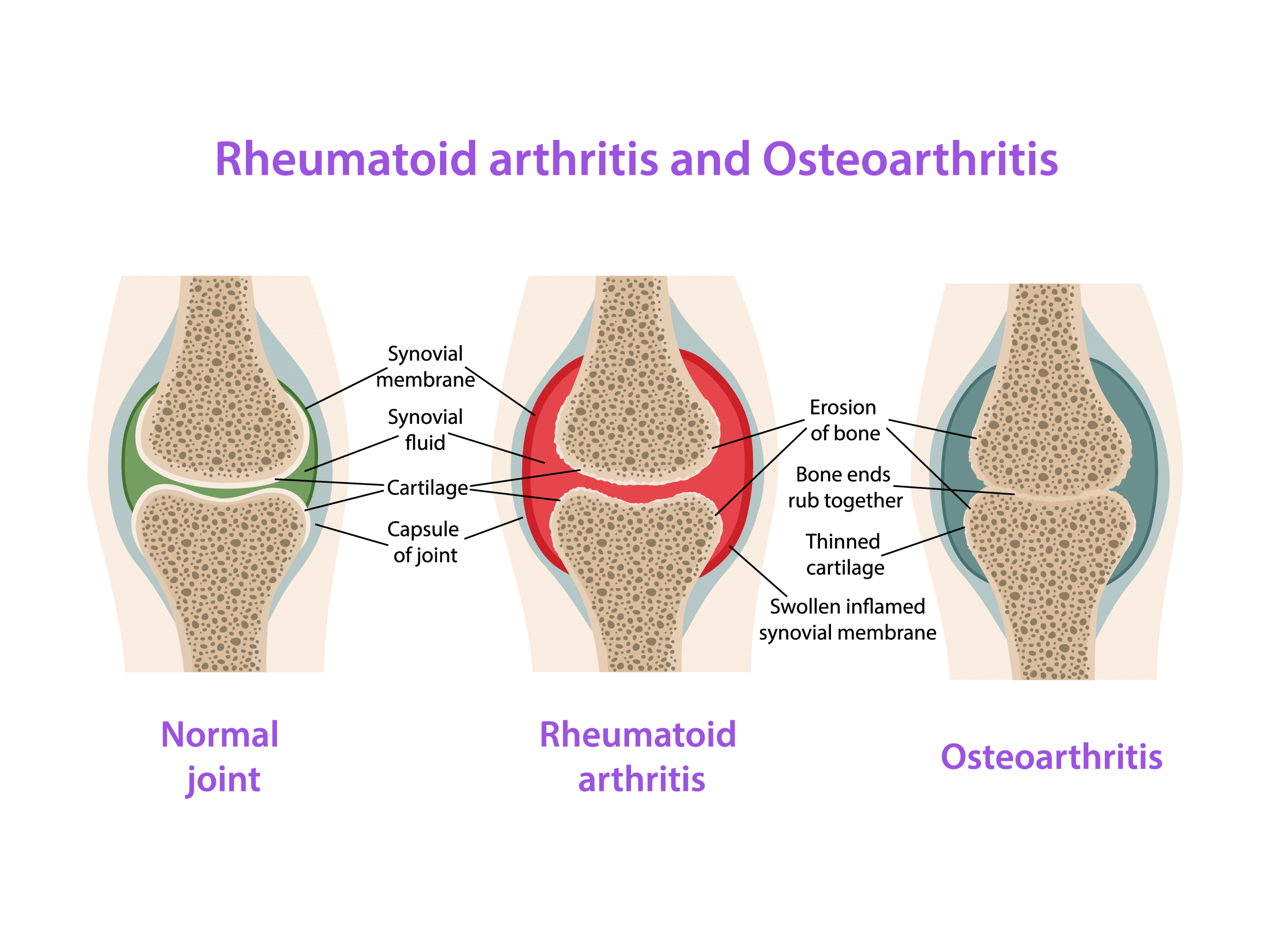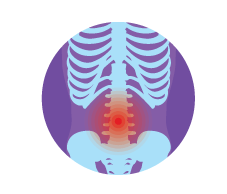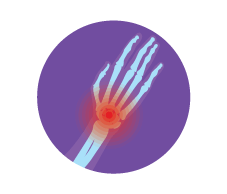Arthritis, Joint Pain, and Back Pain
Common Forms of Arthritis, Joint Pain, and Back Pain
Rheumatoid arthritis (RA)
Rheumatoid arthritis (RA) affects 1 in 100 Canadians. It is a painful, chronic, and usually progressive
The symptoms of RA can vary but generally include joint pain, stiffness, swelling, and fatigue. Symptoms (especially joint pain and stiffness) are worse after a period of immobility. This makes mornings and prolonged sitting difficult. People with RA can also experience flares when their symptoms are much worse for a period of time, before returning to their baseline; they can also have periods where their symptoms cause few problems.
Flares are one of the particular challenges that people with arthritis face. They could be feeling fine one day and end up in the hospital the next day.
Flares involve intense pain and are often associated with extreme fatigue. The cause is unknown. It can be difficult for colleagues and managers to understand the unpredictable and debilitating nature of flares. They can make planning workloads challenging. Managing flares in the workplace requires close communication and understanding between employees and employers.

Osteoarthritis (OA)
Osteoarthritis (OA) is the most common type of arthritis, currently impacting more than 3.2 million Canadians – about 1 in 10 people. OA is often described as “wear-and-tear” arthritis, but this incorrectly describes the disease process. It is now recognized as an imbalance between cartilage breakdown and cartilage repair, where the body cannot keep up with repairing damaged joint tissues. Damage often occurs from prior injury, as a result of aging, or from excessive load on the joint. Many factors can contribute to OA; some include: age, weight, gender, occupation, history of injury or surgery, and genetics. The symptoms of OA can include enduring joint pain and stiffness, and loss of flexibility.
Other forms of arthritis:
Ankylosing spondylitis (AS)
Ankylosing spondylitis (AS), affects 1 in 200 Canadians, primarily affects the spine. It can also affect other joints, tendons, and ligaments. Similar to other forms of arthritis, symptoms can vary but generally include pain and stiffness in the lower back and hips. AS is often diagnosed when people are in their teens or early 20s but can be diagnosed as late as the early 40s.
Juvenile idiopathic arthritis (JIA)
Juvenile idiopathic arthritis (JIA) develops in children under the age of 16. It affects 1 in 250 children. JIA occurs when the body’s immune system attacks healthy tissues in the body creating inflammation and damage. It most commonly affects the joints, but can also involve the eyes, or in severe cases, the heart or lungs. Some forms of JIA are more common in girls. However, other than genetics and environmental factors (e.g., viruses), little is known about the risk factors of JIA.
Psoriatic arthritis
Psoriatic arthritis affects 30% of patients with psoriasis and causes swelling and pain in and around the joints, as well as a scaly rash on the skin. The joints most commonly affected are the wrists, knees, elbows, shoulders, ankles, fingers, and toes. Most people are diagnosed between the ages of 20 and 50. Obesity and having a relative who has psoriatic arthritis are among the risk factors.
Gout
Gout affects 1 in 30 people and is caused by a buildup of uric acid in the body. Symptoms generally include severe pain and swelling, and it often affects the big toe but can include any other joint in the body. It is nine times more likely to occur in men than in women. Red meat, seafood, and alcohol consumption can increase the risk of gout; people who are overweight are more likely to develop gout. It can occur at any time, but affects people over the age of 40.
Lupus
Lupus is an autoimmune disease that affects 10 times more women than men: that means around 1 in 1,000 women will be diagnosed with lupus. The disease involves the body’s immune system attacking healthy tissue in various parts of the body. Tissues affected can include the skin, joints, muscles, kidneys, lungs, heart, blood cells, and brain. Common symptoms are fatigue, fever, skin lesions, and joint pain. Lupus is 10 times more common in women than in men. While it can start at any age, it occurs in most people between the ages of 15 and 45.
And more
Another aspect of understanding arthritis, joint pain, and back pain is the likelihood of having other chronic conditions at the same time (i.e., a comorbid condition). Many people with arthritis also have another condition such as heart disease, depression, or anxiety. It is also very common for people who have been newly diagnosed with arthritis to feel anxious, depressed, or have a sense of loss and anger at their diagnosis.

Back pain
Back pain is experienced by as much as 80% of the adult population. People can experience back problems due to muscle strains or displacement of an intervertebral disc (i.e., a slipped disc). In many cases, back pain is a temporary condition. However, it can be a sign of a more chronic condition, for instance, many patients report back pain is one of the first signs of ankylosing spondylitis.

Joint pain
Joint pain can have many different causes. Although the origin may be different, the shared symptoms of pain, inflammation, and functional limitations are common. There is potential for unique symptoms and impacts to present themselves and for people to experience the same symptoms differently.
